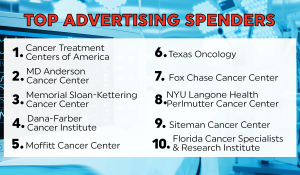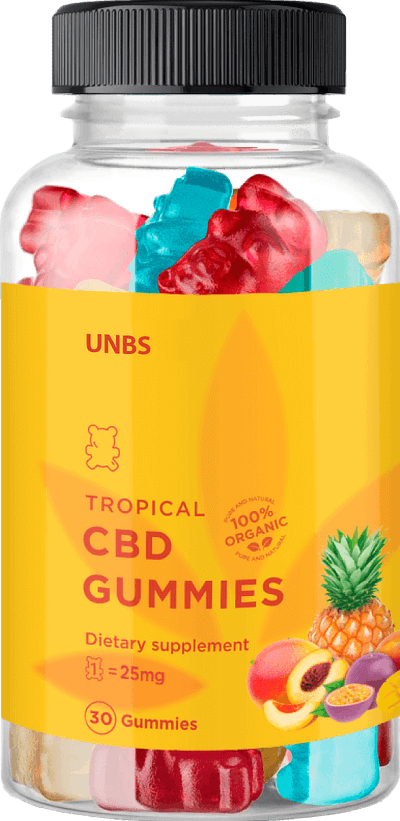
Best Reader Tips of 2021
This year reader tips led to dozens of ad alerts, as well as a complaint to regulators.
TINA.org files complaint against CTCA and puts 42 cancer centers on notice for marketing atypical testimonials.
|
Editor’s Note: Updates have been posted at the end of this article.
When it comes to cancer, there is reason for hope. Thanks in part to advances in the prevention and treatment of many early-stage cancers, the cancer death rate in the United States has been on the decline since 1991. But this hopeful narrative is tempered by the sobering reality that more than 600,000 people will die from cancer in the United States this year and over 1.7 million new cases will be diagnosed. And for those with metastatic or stage 4 cancer, it is still the case that the majority will eventually succumb to the disease. These statistics cannot be ignored in the messaging of hope for cancer patients.
As the cancer death rate has declined, advertising spending by cancer centers has increased — exponentially. Between 2005 and 2014, the amount spent by U.S. cancer centers on advertising soared 320 percent, from $54 million in 2005 to $173 million in 2014. Today, there are more than 1,200 accredited cancer centers competing against each other for patients, who pay billions of dollars in out-of-pocket expenses for cancer treatment every year.
 A yearlong investigation by TINA.org examined the marketing materials of the 50 cancer centers that spent the most on advertising in 2017. At the top of the list was for-profit chain Cancer Treatment Centers of America (CTCA), which accounted for nearly $69 million of the more than $140 million expenditure. What TINA.org found was that 90 percent of the cancer centers still in business in 2018 – 43 out of 48 – were deceptively promoting atypical patient experiences through the use of powerful testimonials.
A yearlong investigation by TINA.org examined the marketing materials of the 50 cancer centers that spent the most on advertising in 2017. At the top of the list was for-profit chain Cancer Treatment Centers of America (CTCA), which accounted for nearly $69 million of the more than $140 million expenditure. What TINA.org found was that 90 percent of the cancer centers still in business in 2018 – 43 out of 48 – were deceptively promoting atypical patient experiences through the use of powerful testimonials.
TINA.org has catalogued more than 700 testimonials featuring patients with cancer types that have a less than 50 percent five-year survival rate that have been deceptively used in marketing materials to advance the narrative, either explicitly or implicitly, that treatment at a particular cancer center will provide patients with a therapeutic advantage, allowing them to beat the odds and live beyond five years. In each of the 700-plus instances, the cancer center failed to clearly and conspicuously disclose what is typical for such patients, that is, a 50 percent chance or greater of dying within five years.
As a result of these findings, TINA.org has filed a complaint with the FTC against CTCA, a repeat FTC offender, and put the other 42 cancer centers on notice that they are engaging in deceptive marketing practices. (See more about these cancer centers below, under the subhead “Follow the Leader.”)
To learn about TINA.org’s investigation by the numbers, click here.
FTC v. CTCA — Round 2?
More than 20 years ago, CTCA entered into a consent agreement with the FTC that, among other things, barred it from making misleading use of patient testimonials in its marketing. CTCA is no longer bound by that consent agreement, which ran from 1996 to 2016. But that does not give the Florida-based company license to violate FTC law, which over time has only required more information when it comes to the marketing of atypical testimonials.
And the company’s advertising is replete with testimonials documenting the unusual successes of its cancer patients. In fact, TINA.org’s investigation catalogued more than 130 instances in circulation in 2018 in which a cancer patient with a life-threatening diagnosis was portrayed by CTCA as doing well after receiving treatment at one of the company’s five treatment centers. What’s missing? The material information that the majority of cancer patients with the same diagnosis do not survive five years.
Take CTCA patient Chuck G., who, after being diagnosed with stage 3 esophageal cancer in early 2001, stated: “By early October 2001, I was cancer free. … My recovery defies all statistics. But I agree with my doctors that ‘statistics mean nothing to believers.’” (The five-year survival rate for patients with stage 3 esophageal cancer is 23.6 percent.) Then there’s George R., a stage 3 lung cancer patient diagnosed in 2009, whose wife credited CTCA for giving George “his life back,” adding: “He has a life that I never thought he was going to have.” (The five-year survival rate for patients with stage 3 lung cancer is 29.7 percent.) And CTCA patient Russel celebrated being a five-year lung cancer survivor by jumping out of a plane. (The five-year survival rate for patients with lung cancer is 18.6 percent.)
As the largest cancer center advertiser in the country, spending on average more than $90 million a year over the last three years, CTCA has paved the way for cancer centers across the nation to use the same deceptive tactics to lure patients to their facilities.
Follow the leader
The 42 cancer centers following CTCA’s lead are a mélange of mainly nonprofits, which are immune from FTC action, and for-profits; university-affiliated centers; and include 18 National Cancer Institute-designated hospitals. They span the country, from Florida (Florida Cancer Specialists) to Washington state (Seattle Cancer Care Alliance) to Pennsylvania (Penn Medicine Abramson Cancer Center) to Kansas (University of Kansas Cancer Center). The top-five ad spenders (CTCA, MD Anderson Cancer Center, Memorial Sloan Kettering Cancer Center, Dana-Farber Cancer Institute and Moffitt Cancer Center, in that order) account for 76 percent of the total expenditure of $140 million, and 43 percent of the entries in our database of more than 700 cancer patient testimonials. Roughly half the testimonials present patients with stage 4 cancer. Here are a few examples from social media (Note: OSUCCC stands for the Ohio State University Comprehensive Cancer Center):
Playing on cancer patients’ hopes and fears
Any cancer center can find a patient who has beat the odds. But using that atypical experience to play on the hopes and fears of such a susceptible patient population has real consequences. Studies show that consumers in general put more trust in the motives of medical institutions than they do other types of marketers. And cancer patients in particular, who are deciding where to go for treatment or for a second opinion, may look at these testimonials not as advertising designed to generate revenue but as educational material that provides objective information about typical results. Some may feel a commonality with the patients featured in the testimonials and believe that their medical journey will mirror the one depicted in the ad. And that, in turn, may convince them to stop their search for a cancer treatment center, even if there are geographically closer, better, or less expensive options available. In fact, CTCA says nearly 70 percent of its patients travel from out of state for treatment.
Consider the testimonial of Jackie T., a CTCA stage 4 lung cancer survivor who wrote: “Yes, it was hard to be away from home in the beginning, but here I am alive, eight years later, so it was well worth it.” But it would also be well worth it for CTCA to inform consumers that the five-year survival rate for patients with stage 4 lung cancer is 4.7 percent, which CTCA fails to do.
Then there’s CTCA patient Jim M., a stage 4 pancreatic cancer patient (five-year survival rate: 2.7 percent), who wrote in his testimonial: “[My wife] found a story about a woman who had stage IV pancreatic cancer and is now a survivor. She had gone to Cancer Treatment Centers of America (CTCA). So I called the hospital system, figuring if she could do it, I can, too.”
It’s possible that the woman Jim is referring to here is Peggy K., who has been something of a celebrity spokesperson for CTCA. After being diagnosed with stage 4 pancreatic cancer, Peggy was given two months to live, the story goes. But not by a doctor at CTCA. When she went to CTCA for treatment, she was told, “You have no expiration date.”
The above marketing materials attest to the need for clear and conspicuous information about the limits of the treatment available at any cancer center.
CTCA’s disclosures don’t cut it
Numerous CTCA testimonials, including Peggy’s above, feature the written disclaimer: “No case is typical. You should not expect to experience these results.”
This type of disclosure might have passed muster in 1996 when CTCA and the FTC came to terms on the consent agreement. But that was before the agency rewrote the rules governing the use of testimonials, in 2009, to say that such disclaimers are not sufficient because consumers believe that theirs will be the atypical experience depicted in the ad. Today, if an advertiser wants to present atypical results in a testimonial, it must also say what is typical and make the disclaimer stand out, or, as the FTC likes to say, the disclaimer must be “clear and conspicuous.”
When CTCA has attempted to disclose information about typical outcomes in its testimonials, the disclosures have left a lot to be desired. For example, in a “Patient Stories” section of its website, CTCA merely linked to survival rates in testimonials for 11 “Distant (Metastatic)” cancers. But even if consumers do click to view this information, the survival rates displayed don’t come close to telling the whole story. For one thing, CTCA’s sampling size is quite small. Excluded from its sampling are cancer patients for whom travel was not an option, because of ailing health, the cost of travel, or myriad other reasons. For another, the sampling only includes patients who were diagnosed and/or started their treatment at CTCA. So right away, this selection bias will skew the numbers in CTCA’s favor.
Then there’s this: A 2013 Reuters investigation found that CTCA rejected certain patients including the elderly, uninsured, and those covered by Medicaid in order to boost and advertise survival rates higher than national averages. The international news agency also found that CTCA excluded from survival statistics patients who arrive at the center with advanced disease. CTCA responded at the time that its survival data are in “no way misleading, nor do they deviate from best practices in statistical collection and analysis.”
But even if the survival rates CTCA provided were reliable, disclosures like these are insufficient for another reason: Consumers should not have to click on a link to get the information they need, especially when that information affects decisions related to their health. According to the FTC, disclosures “should be placed on the same page and immediately next to the claim, and be sufficiently prominent so that the claim and the disclosure are read at the same time, without referring the consumer somewhere else to obtain this important information.”
A note on clinical trials, and more
A clinical trial is an area of research that is used to study the efficacy and safety of new drugs and treatments, among other things. As such, there is no way to know in advance whether or not the new drug or treatment being studied will provide any benefits, and if it does, whether those benefits will be outweighed by any possible risks. Within TINA.org’s sampling of atypical testimonials, more than 130 tout the benefits of clinical trials. Yet none of them disclose the possible risks and limitations associated with such research. In a similar vein, many of the atypical testimonials in TINA.org’s sampling promote the benefits of immunotherapy and genomic testing, the former a procedure that doesn’t work roughly half the time and the latter an option for select cancers and, generally, only after other therapies have failed. Yet these limitations, not to mention the potential risks associated with the treatments, are not disclosed to consumers in the testimonials of patients who successfully underwent them.
RELATED ARTICLE: Ad or Not? Memorial Sloan Kettering and WPIX 11 New York
For example, in the below Facebook post, Smillow Cancer Hospital promotes both the benefits of clinical trials and immunotherapy in connection with a testimonial for a stage 4 non-small cell lung cancer patient (five-year survival rate: 4.7 percent), without noting any possible risks or limitations.
Cancer center advertising as educational?
In response to a TINA.org inquiry in 2016, CTCA said: “All of our advertising undergoes meticulous review for clinical accuracy as well as legal approval to ensure we tell our story in an informative and responsible manner, and in compliance with FTC guidelines.”
CTCA said at the time that its ads aim to educate cancer patients and their families, to help them “understand the disease” along with available options for treatment, so that they can make informed decisions about their cancer care. Yet, as the more than 130 CTCA testimonials that TINA.org compiled make clear, the company’s marketing frequently deprives patients of the information they need to make those informed decisions. These testimonials only tell half the story, the half that involves atypical survival after receiving cancer care at CTCA. There is no discernible effort by CTCA to help cancer patients understand the typical disease process in these testimonials. To classify them as educational material is misleading at a minimum.
“Proponents of cancer center advertising argue that it provides valuable information to the public, enabling patients to become informed consumers of their cancer care. However, when you look closely at the content of these advertisements, it becomes clear that they are dominated by emotional appeals and testimonials, overwhelmingly focused on stories of survival or cure, while actual informational content is scant and imbalanced,” said Yael Schenker, director of palliative care research at the University of Pittsburgh. “Significant increases in spending for healthcare advertising across all media markets virtually ensure that patients looking for cancer-related information will encounter these advertisements, and clearly the concern is that imbalanced or misleading advertising content may drive inappropriate decisions about cancer care.”
Enough is enough
That cancer centers would manipulate a message of hope in their advertising to attract new patients to their facilities is simply not acceptable. Cancer patients who face devastating odds of survival have a right to know the truth and not have their vulnerable situation exploited as they seek out treatment.
“TINA.org’s collection of hundreds of atypical patient testimonials misleadingly used by cancer centers makes clear that the industry, as a whole, needs to clean up its act and stop using this unseemly marketing tactic to take advantage of this incredibly susceptible patient population,” said TINA.org Executive Director Bonnie Patten.
Read more about TINA.org’s investigation here.
UPDATES
11/22/20: CTCA has added a disclaimer at the top of its Patient Stories webpage. The disclaimer states: “We understand that no two cancer patients are alike, and neither is their treatment journey. Each patient’s journey, though, has some common traits: strength, determination, persistence and sense of hope in the battle against cancer. Our patients inspire us every day. We tell their stories here, in their words, as a tribute to them.”
This year reader tips led to dozens of ad alerts, as well as a complaint to regulators.
Spam email leads to a fake endorsement from Dr. Oz, among other celebrities.
Supplement MLM takes down dozens of deceptive claims following TINA.org investigation.

